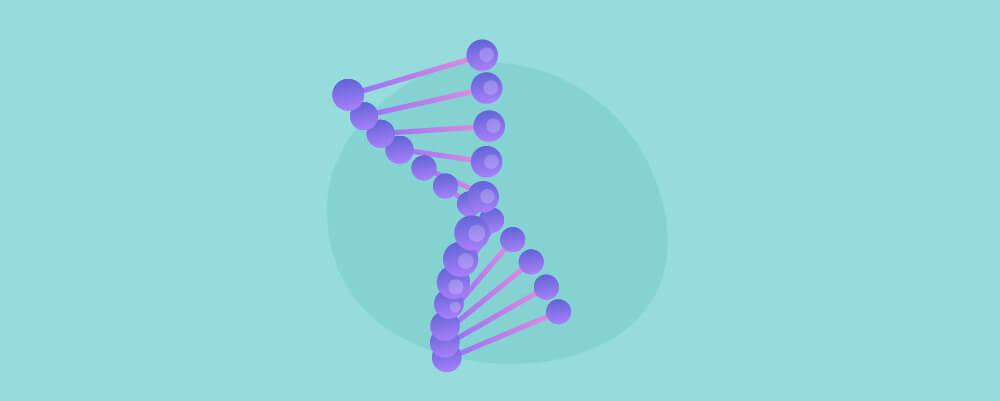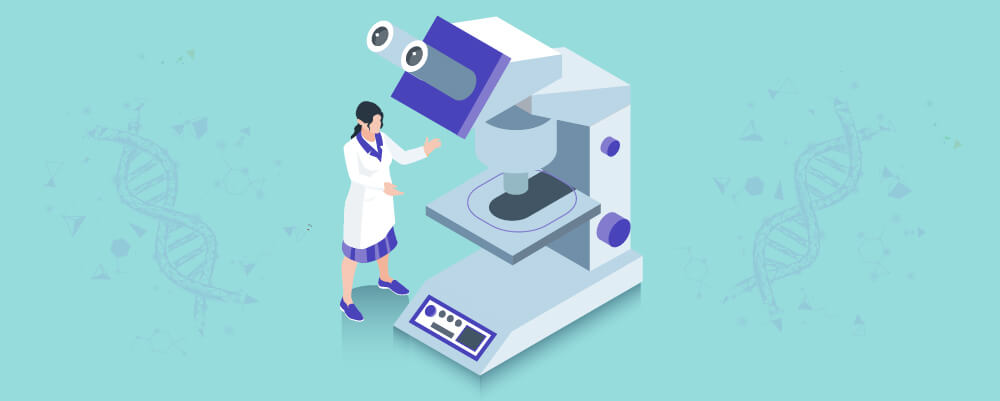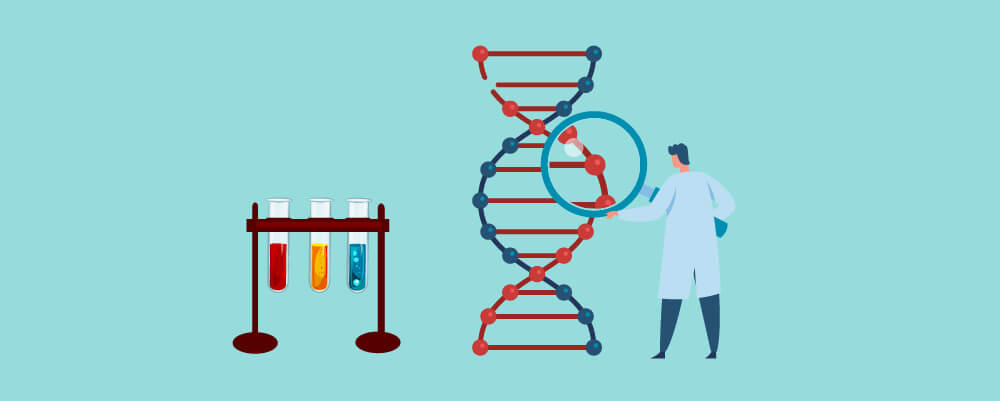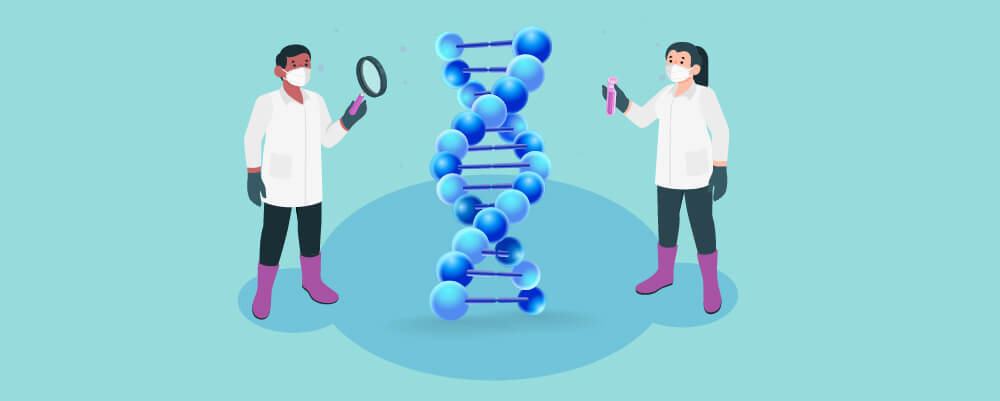Julian, My Biosource 24/8/21

We all know about genetics, how they are made up of DNA. Many young people will have had their first information about genetics and DNA from the legendary film Jurassic Park, which spoke about DNA and genetics in making dinosaurs. However, humans have DNA too, and for us, it can influence everything about us.
Everyone has DNA, and therefore everyone has genes. Genes are the basic physical and functional units of heredity, they are made up of DNA, and you get them from your parents.
How we understand genes is often molded by what we know in popular culture, unless you are a scientist. Films, TV, and even games will talk about genes and how they influence who we are.
However, here we won’t tell you that you can genetically engineer a dinosaur, or that genetic mutations will lead to a zombie outbreak. Here, we are going to tell you the truth about genetics and how they actually affect your life and who you are as a person.
Table of contents
What is A Gene?

Genes are hereditary, made up of DNA, some will act as instructions to make protein molecules. Many genes so not code for proteins, though, and in humans genes vary in size from a few hundred DNA bases to millions.
Long strands of DNA with many genes will then make up chromosomes. So DNA is in genes, genes are in chromosomes and chromosomes are located inside the nucleus of cells. Each chromosome is then one long single molecule of DNA, and this DNA contains very important genetic information.
Genes can vary in how complex they are, every unique living thing can have different shapes and numbers of chromosomes. For example, humans will have 23 pairs of chromosomes, totaling at 46 chromosomes. A hedgehog will have 44, and a fly has only 4.
Genes have one purpose, the storage of information, and every individual gene has the information needed to build up specific proteins that are needed. Our genomes as humans contain 20,687 protein coding genes! We are more complex as beings than you might think.
Genes also come in different forms, which are known as alleles. For us, alleles of certain genes will come in pairs, with one on each chromosome. If the alleles of a specific gene are the same then the organism will be referred to as homozygous, if they are different, then it is referred to as heterozygous. The phenotype is determined by how the alleles are combined. Blue eyes might be the result of one allele, whereas brown eyes might be the result of another allele. The eventual eye color depends on which alleles are present and how they interact with each other.
The instructions in your genes will determine your features, such as eye color, hair color, height, and so on. There are different types of genes for each different feature. A variant of a gene may have the instructions for brown hair, whereas another may have the instructions for blonde hair. The result will be determined by how these genes interact.
Genes are contained in chromosomes and most human cells contain 23 pairs, one pair of sex chromosomes which can be XX in females, or XY in males. One chromosome of each pair is carried from the female parent, and the other from the male parent. This is what results in children often looking like their parents, and why they will often inherit the diseases that run in their families. So, next time you take a trip to your doctor, and they ask you ‘does diabetes run in your family’, you know that it is because of the genes carried from your parents and your parents parents can contain flaws, such as diabetes. But more on that later.
Genes are also the blueprints that build the chemical machinery that keeps our cells alive, whether the genetics are in a human or an animal, or even a plant. But the number of genes a living thing possesses does not predict any complexity, in fact, humans have nearly 11,000 fewer genes than a water flea does!
Our genetic materials do contain more than just genes, how the cells read and interpret genetic instructions is actually far more complex in humans than in the gene heavy water fleas we mentioned.
To fully understand genes, we also need to understand DNA, as they are interlinked. DNA resembles a spiral ladder, known as a double helix, and a total of three billion rungs connect the two outer stands. The rungs are known as base pairs for the two chemicals that they are made of. Scientists will refer to each of these chemicals by their initials; A which is adenine, C which is cytosine, G which is guanine, and T which is thymine. A will always pair with T, and C will always pair with G.
Hearing this, we might assume that genes do all the hard work to make us what we are, however, this is not entirely true. In DNA, genes don’t do all the hard work, and it is actually the protein that is produced from them that carries out the functions of the information they carry. Genes can often produce multiple proteins, one or none, some will produce something else called RNAS, which have a totally different functional job.
Scientists who work with genes will often best understand them by giving them unique names, gene names can be long and, so they will often either abbreviate the name or assign them a unique title. A good example of this is that a gene on ‘chromosome 7’ is associated with cystic fibrosis, and its scientific name is ‘cystic fibrosis transmembrane conductance regulator’, but that is a bit of a mouthful, so they just call it CFTR. So, if you mingle with scientists, you can understand that a lot of gene related information will be coded. It is just too time-consuming to talk about genes without using abbreviations and code.
What is a gene made up of?

Inside your body, almost every cell is a chemical of DNA, genes are a short section of DNA. Genes and DNA work in tandem. Genes are short sections of DNA, and DNA is made up of countless small chemicals which are called bases. The chemicals can be type A, C, T, or G.
Every gene is a part of this DNA which is made up of an A, C, T, G sequence. Your body will have around 20,000 genes, but around 3,000,000,000 of these small chemical bases. The entire makeup of these bases and genes are what make up your individual genome.
What makes up your genes and genome is individual, and is unique to you, as it contains trace links through your family, and not just links to your parents and grandparents, but from your distant ancestors. This is why it is possible to trace your ancestry back hundreds of years.
A gene consists of four types of chemicals (As, Cs, Ts, and Gs)
Genes consist of a long combination of four nucleotide bases/ chemicals. These chemicals are Adenine, Cytosine, Guanine, and Thymine.
Different combinations of these four chemicals will give people different characteristics. This means that a person who has the combination of ATCGTT might be born with blue eyes, whereas someone else who has the combination of ATCGCT could be born with brown eyes.
So, what genes do is carry these ACGT codes, and each person has thousands of genes and therefore billions of these codes. Genes are a lot like a computer program that provides the individuality of the person they belong to.
Genes are a small section of a long DNA double helix molecule, which has the linear sequence of base pairs we talked about earlier. A gene is therefore any section along the DNA with instructions for the proteins to trigger the action.
Genes both belong to, and contain deoxyribonucleic acid which is DNA, except in some viruses, which consist of ribonucleic acid (RNA).
Any DNA molecule is composed of two chains of nucleotides that resemble a spiral ladder, the sides of this ‘ladder’ are made up of sugars and phosphates. The rungs are then formed by the bonded pairs of the ACGT codes. These bond to each other. An A code on one chain will bond to a T code on the other, which forms the rungs. Then a C on one chain will bond to a G code on the other.
ACTG’s contribute to giving humans various characteristics
ACGT’s are genes, in a way, genetic coding is what we name the way that the four bases of DNA, which are the A, C, G, and T codes, are put together. They are combined in a way that the cellular machinery of our bodies, the ribosome, can read them and then turn them into proteins that will then enact on the instructions of the genes.
In more basic terms, the genes store the information and ACTG’s are strung together in a way that allows our bodies to read this information and pass it on to the proteins, who will follow the instructions. If our bodies were an IKEA bookshelf, then the company is the genes, storing the information on how to build it, the instruction manual is the ACGT coding telling you directly how to build it, and the proteins are the person who is actively building the shelf.
Genes and ACTG’s are like filing cabinets and textbooks, holding information for those active proteins that take the information and turn it into a reality. These proteins perform a whole manner of different tasks in your cells, they will affect your eye color, power your muscles, attack invasive bacteria and so on. Some cells will use genes that contain information on how to make keratin, which is a protein that links together inside your body and produces your hair and your nails.
Your entire body is basically the result of hardworking proteins following the instructions given to them by ACGT codes, which get the stored information from your genes.
Each of these individual cells and chemicals are just as important in making you who you are, they work together to create your uniqueness, from your eye color, to your hair, your nails, your skin, your immune system and more. Everything about your body is the direct result of genes, ACGT’s and proteins working together to build your body.
What is a gene mutation?

A genetic mutation is a change in the sequence of DNA, mutations can result from DNA copying mistakes that are made during the division of cells, exposure to ionizing radiation can also mutate, as well as exposure to chemicals called mutagens, or even infections by viruses. There are germline mutations which will occur in the eggs and sperm and these mutations can be passed onto offspring, whereas somatic mutations can occur in bodily cells and these are not passed onto offspring.
Mutations in the genetics are both totally random and also not at all random at the same time. The consequences of a mutation have no influence on whether a mutation will occur, they can occur randomly to whether the effects of these are useful. This means that beneficial changes to the DNA do not often happen, as an organism could benefit from this. Basically, if an organism gets a beneficial mutation in their lifetime, this information won’t flow back to the DNA in the germ line of the organism. This was noted by Charles Darwin, and it was something he got spot on.
However, mutations do not always occur with equal chance. Some may happen more frequently than others, as they are preferred by lower level chemical reactions. These reactions are usually also why mutations are an inescapable probability of any organism that can reproduce.
Overall, gene mutations are both random and not random at the same time. Truthfully, the randomness of mutations depends on the parents and the individual cells.
A change in one or more genes
Mutations are abnormal changes in the DNA of a gene, the building blocks of our DNA are called bases and the sequence of the bases determines the gene and how/ what it functions. Mutations simply involve changes in the arrangement of these bases that make up a gene (A, C, G, T bases). Even just one subtle change in one base, among all the thousands of bases that make up a gene, can have a major effect. It is a bit like the butterfly effect, where one small thing can make a major impact.
A gene mutation can affect the cell in multiple ways, for example some mutations can actually prevent a protein from being created at all Others might change the protein that is made so that it doesn’t work the way that it should, or it may simply be a moot protein where it does not work at all. When a mutation is present it can have no noticeable effect, or there is the possibility that it may lead to a disease. A good example of this is when a certain mutation takes place in the gene for hemoglobin, the result is a disease called sickle cell anemia.
Mutations in cells can also lead to cancer on some occasions too, oftentimes a multitude of mutations are needed before a cell becomes a cancer cell, these mutations could affect different genes that control cell division and growth. We also have genes that are called tumor suppressor genes, and you can guess what a mutation could do to them. Mutations can also cause some normal genes to cause cancer too.
The mutation of genes can lead to disorders or illnesses. In popular culture, such as movies, TV, and games, they will often have mutations in genetics result in zombies, any zombie films, or games such as Resident Evil, touch on this subject and talk about genetics. However, a genetic mutation won’t turn you into a monster like in Resident Evil, instead it might do nothing, or it could result in anemia, diabetes, and in some cases more serious conditions such as cancer.
There are several scales of mutations, for example, a small scale mutation is a change in one base of the DNA sequence. For example, if the original sequence was ‘TAACTGCAGGT’, but the point mutation happened, and it ended up as ‘TAACCGCAGGT’, then this is small scale, as the second T base has become a C base. There is also another type which is called substitution and is where one or more bases in the sequence is replaced by the same number of bases, but a different base. So if cytosine is substituted for adenine, then this is a base substitution mutation.
There is also inversion substitution where a segment of a chromosome is reversed end to end. In this instance, ‘TAACTGCAGGT’, could become ‘TAACACGTGGT’. Another possibility is insertion, which is when a base is added into a sequence, extending it. Or deletion when a base is deleted from a sequence making it shorter.
It is also possible for much larger scale mutations to occur. These can be as severe as CNV (copy number variation) which is where large chunks of DNA are inserted, repeated, or lost. These chunks can be anything from 10,000 to 5,000,000 bases long. You can also have the duplication of genes, deletions of large areas of a chromosome, and the loss of one copy of a gene in an organism that had two copies prior.
We can inherit mutations, as our genes are a copy from our parents. If there is a mutation is one of the genes we get from them, this can be passed from parent to child along with the other genes.
Small inherited changes are able to make big differences for us. This is why cystic fibrosis is most often caused by a mutation that loses three of the letters in a gene that we know as CFTR. However, despite that mutations are common, inherited diseases are actually rare, this is because diseases that we inherit are often in need of two copies of this mutated gene for the disease to become active.
Causing loss of one or more genes
The aforementioned gene deletion is when one or more bases are deleted from the sequence. It is also possible for whole genes and even whole chromosomes to get deleted. Deletions involve the loss of DNA sequences. The effects of these deletions depend on the size and location of the deleted sequences. Deletions that span a centromere can result in an acentric chromosome that is likely to be lost during a division of cells. Duplicates and deletions are both likely to affect the dosage of gens, and therefore will have different results on the person.
It is worth noting that the larger the loss, the more genes that are likely to be involved, and the more genes that are involved, the more drastic the defect will be.
Some genes require two copies of the same gene to function normally, in cases such as this, if one copy remains and one is lost then a mutant phenotype is the result.
There is also the possibility of monosomy, which is the loss of one chromosome in a cell, ‘mono’ is Greek for ‘one’ and people who have this have only one copy of a chromosome in their cells instead of the two that are often there. A common condition caused by this is Turner syndrome, which is also known as monosomy X.
Re-arranging genes/ whole chromosomes
There are many ways in which a gene or chromosome can completely rearrange itself. Obviously, as stated, there are instances where a deletion, or duplication may occur. However, these are not necessarily complete rearrangements. Translocation, on the other hand, can be. A translocation happens when a piece of one chromosome breaks off and then attaches to another chromosome. This is considered to be a balanced rearrangement, should no genetic material be gained or lost inside the cell. If there is a gain or a loss, then this is considered to be unbalanced.
A rearrangement is also possibly an inversion. Which will occur when a chromosome breaks in two places, the resulting combination has a piece of DNA reversed and re-inserted into the sequence. It is possible that genetic material can be lost as a result of this. On a more serious example, dicentric chromosomes are almost complete rearrangement. Normal chromosomes will have a centromere, a dicentric chromosome will have an abnormal fusion of two chromosome pieces, each having a centromere. This type of fusion is unstable and as a result some genetic material can be lost.
Finally, ring chromosomes are also a possibility, they will often occur when a chromosome breaks in two places, which is typically at the ends of the p and q arms, the arms fuse together and form a ring. When this happens there may or may not be a centromere, and most of the time genetic information is lost near the ends of the chromosome.
The function of a gene

Genes decide pretty much everything about a living being, be it a person, animal, or plant. One or more genes can easily affect a specific trait. Genes can also interact with an individual’s environment as well, and they will change what the gene makes. They affect hundreds of internal and external factors, they can influence eye color, hair color, skin color, and any diseases or conditions that a person may develop, as well as possible hereditary weaknesses.
Diseases such as sickle-cell anemia, and Huntington’s disease are both inherited and are also affected by genetics.
A parent carries a gene mutation through an egg or sperm, passing it to their child:
(Genetic conditions- diseases that are inherited from your family, e.g. sickle cell anemia and cystic fibrosis.)
Genes play a role in nearly every health condition and characteristics of health, there are also some conditions where the genetic changes are directly responsible for causing a condition. Scientists and doctors refer to these as genetic disorders and inherited diseases.
Genes are passed from parent to child, and so any changes to the DNA within a gene are also passed onto offspring as well. Although, it is possible that DNA changes can happen spontaneously, showing up seemingly out of nowhere for the first time within the child, while the parents are unaffected. This is a new mutation. It is possible that a mutation like this can cause mistakes in the instructions to the proteins, which can lead to a protein that does not do its job properly, or in more serious instances, cannot be made at all. Where this happens, you get a genetic disorder.
Scientists have discovered more than 10,000 genetic conditions.
Scientists believe that more than 10,000 conditions are actually caused by changes in single genes. These can arise from a change in the gene occurring spontaneously during the formation of the egg, sperm, or during conception, it can also happen when a changes’ gene is passed on from a parent to a child that causes health issues either at birth of later on in life, or a changed gene is passed from parents to child, and it causes a genetic susceptibility to a particular condition.
Also affects humans metabolisms e.g. calorie intake.
Genes can also affect your weight, so when you see some people who are bigger or smaller than you, note this can be due to genetics, as genes can affect how your calories are used. Some people’s bodies will use calories efficiently, requiring fewer calories to fuel their body, which can result in leftover calories being stored as fat.
Other people’s bodies will use them less efficiently, needing more calories to fuel the body, so there will be fewer calories to store as fat. This would be considered a high metabolism, and efficient storage would be considered low metabolism.
Scientists are discovering other gene variants, e.g. the development of diabetes and Alzheimer’s.
As science improves it discovered that there are other gene variants, and it is possible (although not all the time) to be more susceptible to developing diabetes, Alzheimer’s, and dementia due to genetics. Inheriting dementia through a single-gene mutation is rare, however genes are thought to play some role in almost every case of dementia.
Similarly, family history is not necessary for an individual to develop Alzheimer’s, however, if you have a family member with Alzheimer’s, you are more likely to develop the disease than those who do not have a direct relative who has it.
Diabetes is more directly genetic, though. If you are a man who has diabetes type 1 then the odds of your child getting diabetes are 1 in 17, if you are a woman with type 1 and your child was born before you were 25 years of age then the child’s risk is 1 in 25. If your child was born after you were 25 then the child’s risk is 1 in 100. However, if you had diabetes before the age of 11 and if both you and your partner have diabetes type 1 then the risk is between 1 in 10 and 1 in 4.
Summary

Genetics affect every part of our lives, and every ounce of who we are. Our health is majorly impacted by our genetics and there is nothing that we can change about that.
Genes are made up of DNA, and they contribute to the proteins in your body influencing your looks, and your immune system. Your genetics are passed down from your parents, and theirs from their parents.
Genetic diseases and conditions can possibly be hereditary, although not every instance of a hereditary disease is influenced by the parent having the same disease, genes can sometimes just increase susceptibility.
Genes have A, C, G, T chemicals which make up the bond of your DNA and genetics, how these function will influence how you function, and your individuality.
